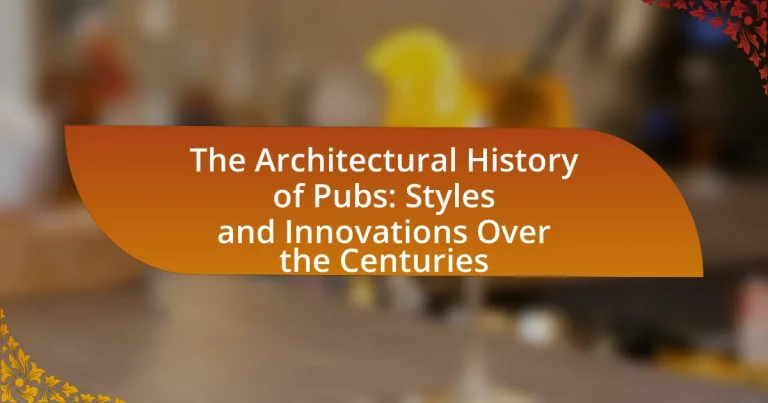The article examines the architectural history of pubs, tracing their evolution from ancient Roman taverns to modern public houses. It highlights key historical periods that influenced pub design, including the Medieval, Tudor, Georgian, Victorian, and 20th centuries, each contributing distinct architectural styles and features. The discussion includes how social and cultural changes have shaped pub layouts and aesthetics, the impact of regional differences and local materials, and the role of technological advancements in construction. Additionally, the article explores current trends in pub architecture, emphasizing sustainability and multifunctional spaces, while addressing practical considerations for designing welcoming environments that balance tradition with modernity.

What is the Architectural History of Pubs?
The architectural history of pubs traces back to ancient Roman taverns, which served as social hubs and laid the groundwork for modern public houses. Over centuries, pubs evolved in design and function, reflecting cultural shifts and architectural styles. In medieval England, pubs often featured timber framing and thatched roofs, while the 18th century introduced Georgian styles characterized by symmetry and brick facades. The Victorian era saw the emergence of ornate designs with intricate detailing, influenced by the Industrial Revolution and urbanization. By the 20th century, pubs began to adopt modernist elements, focusing on functionality and simplicity, yet many retained traditional features to preserve their historical significance. This evolution illustrates how pubs have adapted to societal changes while maintaining their role as communal gathering spaces.
How have pubs evolved architecturally over the centuries?
Pubs have evolved architecturally from simple, functional structures to complex, stylistically diverse buildings. Initially, in medieval England, pubs were often basic inns or alehouses, featuring thatched roofs and timber frames, designed primarily for shelter and serving ale. By the 17th and 18th centuries, the architecture of pubs began to reflect the Georgian style, characterized by symmetrical facades, large windows, and decorative elements, which catered to a growing middle class seeking social spaces.
The Victorian era saw further evolution, with pubs adopting ornate designs, including intricate tile work, stained glass, and elaborate woodwork, as they became central to community life. The introduction of the public house concept led to larger establishments with multiple rooms and specialized areas, such as saloons and dining rooms.
In the 20th century, pubs began to modernize, incorporating Art Deco and later minimalist styles, while also adapting to changing social norms and consumer preferences. Today, contemporary pubs often blend traditional elements with modern design, featuring open layouts and outdoor spaces, reflecting a shift towards casual dining and social interaction. This architectural evolution illustrates the changing role of pubs in society, from basic drinking establishments to multifaceted social hubs.
What are the key historical periods that influenced pub architecture?
The key historical periods that influenced pub architecture include the Medieval period, the Tudor period, the Georgian period, the Victorian era, and the 20th century. During the Medieval period, pubs often featured simple, functional designs with thatched roofs and timber frames, reflecting the local vernacular architecture. The Tudor period introduced more elaborate styles, characterized by half-timbering and decorative brickwork, as seen in many surviving pubs. The Georgian period emphasized symmetry and classical proportions, leading to the development of elegant facades and larger windows. The Victorian era saw the introduction of ornate detailing, including intricate tile work and stained glass, as pubs became more social hubs. Finally, the 20th century brought modernist influences, resulting in a mix of traditional and contemporary designs, often prioritizing functionality and accessibility. Each of these periods contributed distinct architectural elements that shaped the evolution of pub design.
How did social and cultural changes impact pub designs?
Social and cultural changes significantly influenced pub designs by altering their layout, function, and aesthetic appeal. For instance, the rise of the working class in the 19th century led to the creation of larger, more communal spaces to accommodate social gatherings, reflecting the need for inclusivity and community interaction. Additionally, the temperance movement in the early 20th century prompted some pubs to incorporate family-friendly areas and non-alcoholic options, reshaping their environments to appeal to a broader audience. The introduction of modern design elements in the late 20th century, influenced by changing social norms and tastes, resulted in pubs adopting more contemporary aesthetics, such as open-plan layouts and minimalist decor, to attract younger patrons. These adaptations illustrate how pubs have evolved in response to societal shifts, ensuring their relevance in changing cultural landscapes.
What architectural styles are commonly associated with pubs?
Common architectural styles associated with pubs include Georgian, Victorian, and Tudor. Georgian pubs, prevalent in the 18th century, are characterized by symmetry and classic proportions, often featuring brick facades and large windows. Victorian pubs, popular in the 19th century, showcase ornate detailing, decorative tiles, and intricate woodwork, reflecting the industrial era’s wealth. Tudor-style pubs, inspired by medieval architecture, exhibit steeply pitched roofs, exposed timber framing, and decorative half-timbering. These styles not only represent the historical context of their times but also contribute to the cultural identity of pubs in various regions.
What are the defining characteristics of traditional pub architecture?
Traditional pub architecture is characterized by features such as timber framing, brick or stone facades, and distinctive rooflines, often with gables or thatched roofs. These elements reflect historical building practices and local materials, creating a warm and inviting atmosphere. Additionally, traditional pubs frequently include large windows, decorative signage, and a central bar area, which fosters social interaction. The use of ornate detailing, such as carved woodwork and stained glass, further enhances the aesthetic appeal, while the layout typically accommodates both communal and private spaces, catering to diverse patron needs.
How do modern pubs differ in style from historical ones?
Modern pubs differ in style from historical ones primarily through their design, ambiance, and functionality. Historical pubs often feature traditional architecture with dark wood, low ceilings, and cozy, intimate spaces, reflecting the social customs of their time. In contrast, modern pubs tend to embrace open layouts, contemporary materials like glass and steel, and a focus on creating a vibrant atmosphere that accommodates diverse social interactions. For example, many modern establishments incorporate elements such as outdoor seating, craft beer selections, and multifunctional spaces for events, which were less common in historical pubs. This evolution in style reflects changing social dynamics and consumer preferences, emphasizing a more casual and inclusive drinking culture.
Why are innovations important in the architectural history of pubs?
Innovations are important in the architectural history of pubs because they reflect changing social needs and technological advancements. For instance, the introduction of gas lighting in the 19th century transformed the ambiance and functionality of pubs, making them more inviting and accessible during evening hours. Additionally, the shift from traditional timber framing to brick and stone construction in the Victorian era improved durability and allowed for more elaborate designs, which catered to a growing urban population. These innovations not only enhanced the aesthetic appeal of pubs but also influenced their role as community hubs, adapting to the evolving cultural landscape.
What technological advancements have influenced pub construction?
Technological advancements such as prefabrication, advanced materials, and building information modeling (BIM) have significantly influenced pub construction. Prefabrication allows for quicker assembly and reduced labor costs, while advanced materials like engineered wood and sustainable composites enhance durability and environmental performance. Building information modeling facilitates precise planning and design, improving efficiency and reducing errors during construction. These innovations have transformed the construction process, enabling more complex designs and faster project completion.
How have design trends shaped the functionality of pubs?
Design trends have significantly shaped the functionality of pubs by influencing their layout, ambiance, and service models. For instance, the rise of open-plan designs in the late 20th century facilitated social interaction and created a more communal atmosphere, which encouraged patrons to linger longer. Additionally, the incorporation of multifunctional spaces, such as areas for live music or events, has expanded the role of pubs from mere drinking establishments to community hubs. Historical evidence shows that the introduction of outdoor seating areas in the 2000s increased foot traffic and revenue, reflecting a shift towards creating inviting environments that cater to diverse customer needs.
How do regional differences affect pub architecture?
Regional differences significantly influence pub architecture by dictating design elements, materials, and cultural significance. For instance, in the United Kingdom, traditional pubs often feature timber framing and thatched roofs, reflecting local building practices and available resources. In contrast, Australian pubs typically incorporate open-air designs and large verandas, adapting to the warmer climate and outdoor social culture. Furthermore, the historical context of each region shapes architectural styles; for example, Irish pubs often emphasize cozy interiors and dark wood, which align with the cultural emphasis on intimate social gatherings. These architectural variations are not merely aesthetic but also serve functional purposes, catering to local customs and environmental conditions.
What are the unique architectural features of pubs in different countries?
Pubs around the world exhibit unique architectural features that reflect their cultural heritage and local traditions. In the United Kingdom, traditional pubs often feature timber framing, exposed beams, and cozy interiors, with many dating back to the medieval period, showcasing a distinct charm. In Ireland, pubs are characterized by their vibrant facades, often painted in bright colors, and the presence of a snug, a small private area for intimate gatherings, which enhances the social atmosphere.
In Germany, beer halls, or “Biergärten,” emphasize open-air spaces with long communal tables and large canopies, promoting a communal drinking experience, while their architecture often includes rustic wooden structures. In Belgium, pubs frequently display intricate stained glass windows and ornate facades, reflecting the country’s rich artistic heritage.
In Australia, pubs often blend indoor and outdoor spaces, featuring large verandas and beer gardens, which cater to the outdoor lifestyle. Each of these architectural features not only serves functional purposes but also embodies the social and cultural significance of pubs in their respective countries.
How do local materials and climate influence pub design?
Local materials and climate significantly influence pub design by dictating the structural choices and aesthetic elements used in construction. For instance, in regions with abundant timber, such as the UK, traditional pubs often feature wooden beams and paneling, reflecting local craftsmanship and available resources. Similarly, in areas with extreme weather conditions, such as heavy rainfall or high temperatures, pub designs incorporate features like sloped roofs for rain runoff or shaded outdoor areas to enhance comfort. Historical examples include the use of limestone in pubs in the Cotswolds, which not only provides durability but also blends with the local landscape. These design choices are rooted in practicality and cultural identity, ensuring that pubs remain functional and resonate with their surroundings.
What role do pubs play in community architecture?
Pubs serve as vital social hubs in community architecture, fostering interaction and cohesion among residents. They are often designed to reflect local culture and history, contributing to the identity of neighborhoods. For instance, many pubs feature architectural styles that resonate with their surroundings, such as traditional brick facades or modern designs that incorporate local materials. This architectural integration enhances the aesthetic appeal of the community while providing a space for social gatherings, events, and cultural activities, which are essential for community engagement. Historical evidence shows that pubs have been central to community life for centuries, acting as venues for public discourse and socialization, thereby reinforcing their role in the architectural landscape of communities.
How do pubs contribute to the social fabric of their neighborhoods?
Pubs contribute to the social fabric of their neighborhoods by serving as communal gathering spaces that foster social interaction and community cohesion. These establishments often host events, such as trivia nights and live music, which encourage local residents to engage with one another, thereby strengthening social ties. Research indicates that neighborhoods with vibrant pub cultures experience lower levels of social isolation and increased community participation, as pubs provide a relaxed environment for people to meet and form friendships. Additionally, pubs often reflect the local culture and history, acting as landmarks that enhance community identity and pride.
What are the implications of pub architecture on local culture?
Pub architecture significantly influences local culture by shaping social interactions and community identity. The design and style of pubs often reflect regional characteristics, fostering a sense of belonging among patrons. For instance, traditional pubs in the UK, characterized by timber framing and cozy interiors, serve as communal gathering spaces that promote social cohesion and local traditions. Historical studies indicate that the architectural features of pubs, such as open hearths and communal tables, encourage conversation and interaction, reinforcing community ties. Additionally, the preservation of unique architectural styles can enhance local heritage, attracting tourism and contributing to the local economy.
What are the future trends in pub architecture?
Future trends in pub architecture include a focus on sustainability, multifunctional spaces, and technology integration. Sustainable design practices are becoming essential, with materials sourced responsibly and energy-efficient systems implemented to reduce environmental impact. Multifunctional spaces are increasingly popular, allowing pubs to serve as community hubs that host events, co-working areas, and dining experiences, catering to diverse customer needs. Additionally, technology integration, such as contactless ordering systems and smart lighting, enhances customer experience and operational efficiency. These trends reflect a shift towards creating adaptable, eco-friendly environments that meet modern social and technological demands.
How is sustainability influencing pub design today?
Sustainability is significantly influencing pub design today by prioritizing eco-friendly materials and energy-efficient systems. Modern pubs are increasingly incorporating sustainable practices such as using reclaimed wood, energy-efficient lighting, and water-saving fixtures, which reduce their environmental impact. For instance, a study by the UK Green Building Council found that buildings designed with sustainability in mind can reduce energy consumption by up to 50%. Additionally, many pubs are integrating green roofs and outdoor spaces that promote biodiversity, aligning with community values around environmental responsibility. This shift not only enhances the aesthetic appeal of pubs but also attracts environmentally conscious patrons, demonstrating a clear trend towards sustainability in the hospitality industry.
What innovations are emerging in the pub industry regarding architecture?
Innovations emerging in the pub industry regarding architecture include the integration of sustainable design practices, such as the use of reclaimed materials and energy-efficient systems. These architectural advancements aim to reduce environmental impact while enhancing the aesthetic appeal of pub spaces. For instance, many new pubs are incorporating green roofs and solar panels, which not only lower energy costs but also contribute to biodiversity. Additionally, open-plan layouts and flexible spaces are becoming popular, allowing for versatile use and improved customer experience. This shift reflects a broader trend in the hospitality industry towards creating inviting, multifunctional environments that cater to diverse clientele.
What practical considerations should be taken into account when designing a pub?
When designing a pub, practical considerations include layout, capacity, accessibility, and compliance with health and safety regulations. The layout should facilitate efficient movement for both patrons and staff, ensuring that service areas are strategically placed to minimize congestion. Capacity must align with local regulations and the intended atmosphere, balancing comfort with profitability. Accessibility is crucial, requiring compliance with standards such as the Americans with Disabilities Act, ensuring that all patrons can navigate the space easily. Additionally, adherence to health and safety regulations, including fire codes and sanitation standards, is essential to operate legally and safely. These considerations are supported by industry guidelines and local building codes, which provide frameworks for effective pub design.
How can architects balance tradition and modernity in pub design?
Architects can balance tradition and modernity in pub design by integrating historical architectural elements with contemporary materials and technologies. For instance, they can preserve classic features such as wooden beams, brick facades, and traditional layouts while incorporating modern amenities like open spaces, energy-efficient systems, and innovative lighting. This approach not only respects the cultural heritage of pubs but also meets the evolving needs of patrons, as evidenced by the successful renovations of historic pubs that maintain their charm while enhancing functionality.
What are the best practices for creating a welcoming pub environment?
Creating a welcoming pub environment involves several best practices, including comfortable seating, warm lighting, and friendly staff. Comfortable seating encourages patrons to relax and stay longer, while warm lighting creates an inviting atmosphere. Friendly staff enhances the experience by making customers feel valued and appreciated. Research indicates that establishments with a welcoming ambiance see increased customer satisfaction and repeat visits, as noted in studies by the Journal of Hospitality Management, which highlight the correlation between environment and customer loyalty.


